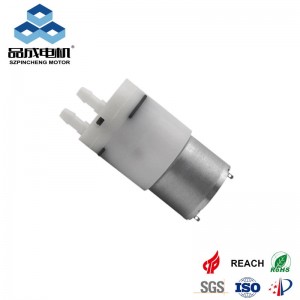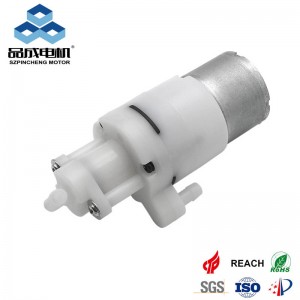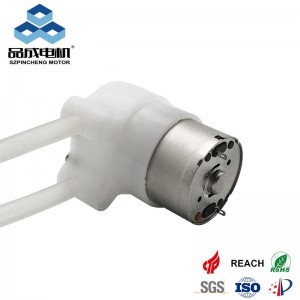Have you thought about how small water pumps work so well? A DC diaphragm pump is the answer. It saves up to 30% more energy than older pumps, making it a significant improvement. Companies like Pincheng Motor manufacture these pumps to be small, powerful, and efficient. Whether it's a mini DC vacuum pump or a larger application, its self-priming feature ensures that water flows smoothly.
Key Takeaways
DC diaphragm pumps use 30% less energy than older ones. They are good for the environment and save money in many uses.
Their small size makes them easy to carry around. This is great for DIY tasks, outdoor fun, and factory work.
Cleaning and changing parts can make the pump last 30+ years. This keeps it working well and dependable.
What Is a Mini DC Diaphragm Water Pump?
Definition and Purpose
A mini DC diaphragm water pump is a small tool that moves liquids easily. It uses a stretchy diaphragm and valves to control water flow. Powered by DC, it works well for tasks needing portability and energy savings.
These pumps are used in watering systems, portable filters, and medical tools. Hobbyists also use them for robots or creative projects. Whether you’re watering plants or making gadgets, this pump helps liquids move smoothly.
Here’s a simple look at its purpose and uses:
|
Specification/Application |
Description |
|
Type |
|
|
Purpose |
Moving liquids in a controlled way |
|
Applications |
Irrigation, filtration, medical tools, hobby projects |
Key Features and Components
What makes these pumps special? Their features make them reliable and useful. Here’s a breakdown:
Compact and Lightweight Design: These pumps are tiny and weigh only 18 grams. They fit in small spaces and are easy to carry.
Self-Priming Capability: They pull water on their own, so you don’t need to fill them first.
Durable Materials: Many are made from strong stainless steel, which lasts a long time.
Wide Temperature Range: They work with liquids as hot as 77°C (170°F), making them versatile.
Energy Efficiency: They use little power, making them great for battery or solar setups.
Here’s a table showing their performance:
|
Specification |
Value |
|
Liquid Flow Rates |
0.3 – 1.6 L/min |
|
Pressure Range |
0.44 – 3.5 bar |
|
Vacuum Levels |
-30 to -100 kPa |
|
Lifespan |
300 – 10,000 hours |
|
Weight |
18g – 4.7kg |
These features are tested to ensure they work well:
Pumps go through aging tests for up to 5,000 hours to check durability.
Fatigue simulations test how they handle frequent starts and stops.
Heat and vibration tests show they can work in tough conditions like extreme temperatures or wet areas.
For instance, the JSG-05T12L model kept 87% of its flow rate after 4,800 hours of testing. That’s great for such a small pump!
With these features and flexibility, mini DC diaphragm pumps are perfect for many uses.
How Does a DC Diaphragm Pump Work?
The Role of the Diaphragm Mechanism
A DC diaphragm pump uses a flexible diaphragm to move water. The diaphragm stretches out to pull water into the pump. Then it pushes back to send water out. This repeating motion keeps water flowing smoothly and reliably.
Why does this design work so well?
A magnetic drive powers the diaphragm, making it move without touching other parts.
Valves inside the pump guide water flow and stop it from going backward.
Studies show the diaphragm’s back-and-forth motion helps move water precisely. This design works even in small pumps, keeping water flow steady.
This simple system makes the pump useful for many tasks. Whether for watering plants or building gadgets, it gets the job done efficiently.
How DC Power Drives the Pump
How does the pump get its energy? It uses a DC motor. This motor turns electricity into movement, powering the diaphragm. DC motors are small, reliable, and save energy, making them ideal for portable pumps.
Here’s how DC motors perform in these pumps:
|
Motor Type |
Efficiency (%) |
Torque Ripple Reduction (%) |
|
BLDC |
> 90 |
37 |
|
SRM |
> 90 |
N/A |
These motors use less power but work very well. They are also lightweight, which makes the pump easy to carry.
Self-Priming and Flow Control
A DC diaphragm pump can pull water from lower levels on its own. It lifts water without needing extra tools, making it great for draining tanks or pumping uphill.
Key facts about self-priming:
It can lift water up to 21 feet high.
It runs quietly and won’t break if it runs dry for 30 minutes.
|
Feature |
Details |
|
Self-priming |
Yes |
|
Max. Suction Height |
-6.5 m H2O |
|
Max. Vacuum |
-700 mbar |
Flow control is another helpful feature. Sensors keep water flow and pressure steady. This makes the pump work well for watering or filtering systems.
By combining self-priming and flow control, the pump makes moving water easier for everyone.
Benefits of Using a DC Diaphragm Pump
Energy Efficiency and Low Power Consumption
A DC diaphragm pump helps save energy. It uses brushless motors that work efficiently. These motors turn 85–95% of energy into useful power. They use 30% less energy than older brushed motors.
For example, a solar-powered pump in a rural project cut energy costs by 60%. This is helpful when resources are limited. These pumps also work well with batteries or solar panels. They are eco-friendly and save money.
Portability and Compact Design
These pumps are small and easy to carry. Their lightweight design fits into tight spaces. Here are some examples:
|
Model |
Weight (kg) |
Dimensions (LxWxH, mm) |
|
D3 SE |
1.5 |
74 x 29 x 52 |
|
D5 SE |
0.3 |
80 x 42 x 80 |
|
D14 SE |
1.0 |
140 x 67 x 127 |
You can use them for DIY projects or outdoor tasks. Their portability makes setup simple and quick.
Durability and Low Maintenance
DC diaphragm pumps are strong and last a long time. Companies test them for up to 10,000 hours to ensure quality. They also check how they handle heat and frequent use.
To keep your pump working well:
- Clean it after each use to remove dirt.
- Replace the diaphragm every 300–500 hours.
- Use filters to stop clogs.
With good care, these pumps can last over 30 years. They are reliable and worth the investment!
Applications of DC Diaphragm Pumps
Home and DIY Projects
Do you like making things at home? A DC diaphragm pump can help. These pumps are small, easy to use, and work well. You can use one to water your garden or make a backyard fountain.
Here’s an example:
|
Project Title |
Description |
Outcome |
|
Double Acting Diaphragm Pump |
A DIY project to build a water pump to lift five liters of water through a height of approximately 600mm using a 24V DC motor. |
The team placed second in a competition based on efficiency among five teams. |
This shows how useful these pumps are. Whether for school or home, they make water tasks simple and fun.
Industrial and Commercial Uses
Factories and businesses use DC diaphragm pumps because they work well. They are used in water treatment, oil, chemicals, and medicine. These pumps move liquids carefully and handle tough jobs.
Here’s how they help:
- Water plants use them to clean water and follow rules.
- Oil and gas companies use them for thick or harsh liquids.
- Chemical factories use them to measure and move fluids safely.
- Medicine makers use them for delicate liquids with high standards.
- These pumps make hard jobs easier in many industries.
Recreational and Outdoor Activities
Going camping or hiking? A DC diaphragm pump can help you. Use it to get water from a stream for cooking or showers. It’s light and easy to carry anywhere.
You can also use these pumps in RVs or boats. They give water for sinks, showers, or cleaning. They last long and use little power, making them great for outdoor fun.
A DC diaphragm pump makes moving water easier in many ways. Its small size and energy-saving design make it useful for homes and industries. Businesses like it because it lasts long and needs little care. Environmental rules also encourage its use. With features like keeping liquids separate and handling chemicals, it works better than other pumps for accuracy and dependability.
The worldwide demand for diaphragm pumps is rising fast. Experts predict it will hit $6.8 billion by 2032. This shows their growing use in water systems, chemical plants, and medicine production.
FAQ
1. How do I choose the right DC diaphragm pump for my needs?
Consider these factors:
- Flow rate: How much water you need to move.
- Pressure: The height or distance water must travel.
- Power source: Battery, solar, or direct current.
Tip: Check the pump’s specifications to match your project’s requirements.
2. Can I use a DC diaphragm pump for hot liquids?
Yes, many pumps handle liquids up to 77°C (170°F). Always check the temperature range in the product manual before use.
3. What maintenance does a DC diaphragm pump need?
- Clean the pump after each use.
- Replace the diaphragm every 300–500 hours.
- Use filters to prevent clogs.
Note: Regular maintenance extends the pump’s lifespan and ensures smooth operation.
you like also all
Read More News
Post time: Jun-04-2025




